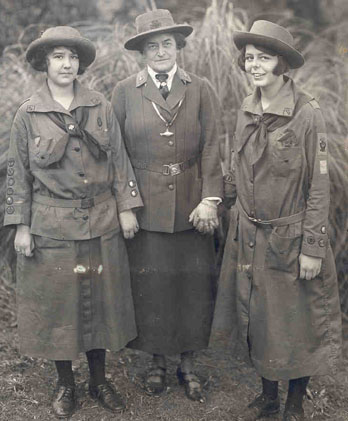100 Years of Girl Scouts

In 2012, the Girls Scouts of the USA celebrated their 100th anniversary.
by Jennie Wood
 Two Girl Scouts with Juliette Gordon Low (center) Related Links |
March 12, 2012, marked the 100th anniversary of the Girl Scouts. As of 2012, there were 2.3 million girl members, 900,000 adult volunteers, and more than 50 million Girl Scout alumnae. The numbers were astounding when compared to the organization's humble beginnings.
The idea of the organization came to Juliette Gordon Low, an American from Savannah, Ga., in 1911. Low was in England where she met Robert Baden-Powell, the founder of Boy Scouts and Girl Guides. During her time in Great Britain, Low organized Girl Guide troops. On March 12, 1912, back in Savannah, she formed a Girl Guide troop with 18 girls.
A Century of Milestones
Low's goal was to get the girls out of their homes and expose them to many of the same opportunities and adventures boys their age experienced. She was also dedicated to promoting diversity, making sure that African-American, American-Indian, and Hispanic girls were welcomed as Girl Scouts. In the 1920s, the first Native-American Girl Scout Troop was founded in New York and a Mexican American troop was formed in Houston, Texas. Also in the 1920s, Girl Scout Troops on Foreign Soil (TOFS) was founded for American girls living abroad.
Another early focus of Girl Scouts was community service. In the 1930s, Girl Scouts collected food and clothing and worked in hospitals during the Great Depression. The first Girl Scout cookies were sold during the depression. Girl Scouts also contributed to the war effort during World War II, collecting over 1.5 million clothing items, operating bicycle courier services, and teaching survival skills to 10,000 women.
During the 1960s, the Girl Scouts National Board issued statements in support of civil rights. To fight racism, Girl Scout Speakout conferences were held throughout the country. In the 1980s, the Contemporary Issues publications began, helping girls confront serious issues such as suicide, drugs, and child abuse. In the next decade, Girl Scouts battled illiteracy, working with First Lady Barbara Bush on the Right to Read service project. Also during the 90s, Girl Scouts Beyond Bars, the first and only mother-daughter prison visitation program, was founded. In response to the September 11, 2001, attacks, Girls Scouts held remembrance ceremonies and performed a variety of community services.
Still Paving the Way
Nearly a 100 years after being established, Girl Scouts of America continues to find new ways to promote diversity in their organization. In the fall of 2011, a Colorado troop admitted a 7-year-old transgender. The action sparked controversy from within the organization. Three troop leaders in Louisiana resigned. One California teen launched a national Girl Scout cookie boycott in January 2012 over the incident. Girl Scouts of Colorado said in a statement, "If a child identifies as a girl and the child's family presents her as a girl, Girl Scouts of Colorado welcomes her as a Girl Scout."
In honor of the 100th anniversary, a new cookie was introduced. Savannah Smiles, a lemon wedge cookie, was named in honor of Juliette Gordon Low's hometown.
In March of 1912, Low started Girl Scouts of the USA to provide an outlet for girls as well as teach them courage, confidence, and character. Expanding into a global organization over the years, Girl Scouts has provided numerous community services while becoming a major voice against discrimination.







